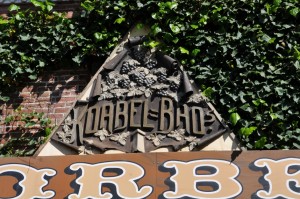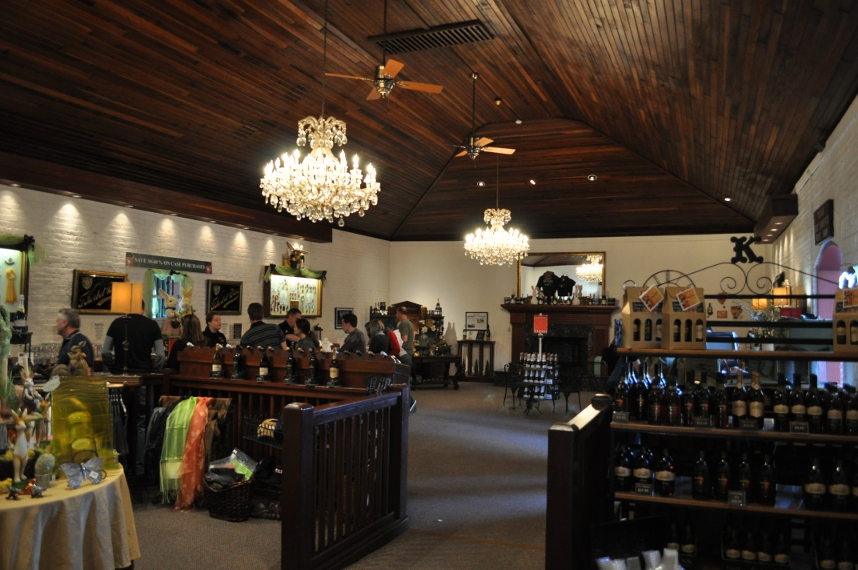Last Sunday, we took the tour of the Korbel – as in champagne – winery, in Guerneville. Korbel has a few billboards around the area advertising themselves as “voted – the best winery tour”. So, what the heck…
The tour is free. They give you some family history of the Korbel brothers who started the place back in the 1880’s. The brothers were political dissidents in the Hapsburg empire (Germany?) and escaped from prison and fled to America. Originally starting out as cigar-box makers, somehow they got the idea to make champagne (I forget exactly how). But the industrial processes they learned/invented to do cigar-boxes, as well as the business connections they developed, worked to get started in the champagne business. Printing 4-color labels for their cigar boxes being one highlight. They were the first to bring the 4-color printing press to gold rush California.
The tour doesn’t cover a lot of the extensive grounds. They have a history museum that they run you through very quickly. The Korbels were like everybody else in coastal northern California back then – all those giant redwood trees covering the land were to be cut down and made into things – houses, cigar boxes, wineries, whatever. The building you tour – which they say is still the world headquarters of Korbel winery – is still standing from the original redwood it was made of; with only slight damage from the 1906 earthquake. You watch a 12 minute video. Then you walk through old wine cellars with very big barrels in them. They are, apparently, still in use. They show you a few steps of the old process of making champagne, including the role of the “riddler“. Nowadays, of course, the process is vastly more automated.
Then it’s to the tasting room, where you get to taste about 5 different kinds of their champagnes. Since champagne is a process, not a grape, you can use just about any kind of grape or mix of grapes to make champagne. This makes sense, but I was totally used to thinking that Korbel is just one kind of champagne. That is, when you go to the store to get a bottle of Korbel champagne – there was only 1 choice as far as I could tell. Perhaps next time I’ll look around to see if I can find the other Korbel champagnes.
They sell you their product in their tasting room, of course. I did not buy any champagne. Instead, I bought a bottle of their port – very good! And a bottle of their “XS – Extra Smooth” brandy. (haven’t tried the brandy, yet.)

Interesting couple of stories they tell you while you’re sipping their products…
One – A few years back, the system of wine naming was created and people who didn’t make their champagne in Champagne, France, were prohibited from calling their effervescent wine “champagne”. Except that 2 or 3 well established champagne makers, who use the actual champagne process but aren’t in Champagne, were grandfathered in. Korbel being one of them. So, Korbel can legitimately call their product “champagne”. Everybody else (outside Champagne) has to call their product something else, like “sparkling wine”.
Two – Hollywood wanted to make a film on their vineyards in the early 1900’s, but the Korbel brothers would hear nothing of it. After repeated attempts by the studio to convince the Korbels to let them make a war film (about WW-I, maybe), they finally struck a deal with the Korbels. Turns out that when the Korbels cut down all the redwood trees, they didn’t bother removing the stumps. In fact, they cut the trees at about 10-15 feet above ground. The result was that there were a lot of very big stumps all over the property. They just planted the grape vines around the stumps. (there’s photographs of this in the history museum.) Since the filmmakers wanted to make a war movie the Korbels said, everytime you have an explosion for your film, you also have to blow up one of my stumps. The studio agreed and the Korbels got their stumps cleared out. End note: before the stumps were cleared out the local name for the area was “Stumptown“.
Oh, and three – The Korbel family sold the business to the Heck family in the 1950’s, who did a lot to bring the operation into the 20th century. And brought with them more modern sagas of family fortunes. (this part of the story they don’t tell you in the tasting room)
Coda: I tend to agree with this reviewer about the tour. I came away sorta disappointed that you don’t see anything of the modern operations.
Here’s a pic of the tasting room:

Thank you for helping out, wonderful information.